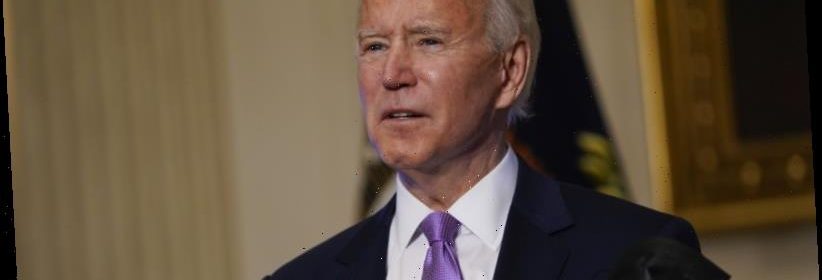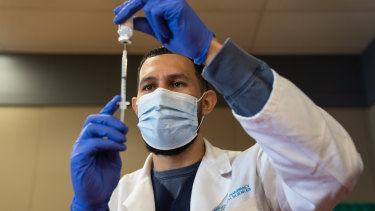‘Wartime effort’: Joe Biden administration to boost vaccine supply

Washington: The Biden administration is boosting purchases of coronavirus vaccines to deliver enough to protect 300 million Americans by the end of the summer, – nearly enough for the entire US population – as it surges deliveries to states for the next three weeks following complaints of shortages and inconsistent supplies.
President Joe Biden announced the surge in deliveries to states on Tuesday, local time, along with the news that the federal government is purchasing an additional 100 million doses each of the two approved coronavirus vaccines. With existing purchases, the White House expects to be able to deliver enough of the two-dose regimens to states to vaccinate 300 million people.
Vials of the Moderna COVID-19 vaccine at a mass vaccination super site in Chula Vista, California. Credit:Bloomberg
“This is enough vaccine to vaccinate 300 million Americans by end of summer, early fall,” Biden said, calling the push to increase supply a “wartime effort.“
The purchases from drugmakers Pfizer and Moderna come as the Biden administration is trying to ramp up vaccine production and states’ capacities to inject them into arms. Even more vaccine could be available if federal scientists approve a single-dose shot from Johnson & Johnson, which is expected to seek emergency authorisation in the coming weeks.
Biden also announced a roughly 16 per cent boost in deliveries to states over the coming weeks, amid complaints of shortages so severe that some vaccination sites around the US had to cancel tens of thousands of appointments with people seeking their first shot.
Detailed figures posted on the Centres for Disease Control and Prevention website on Tuesday showed that the government plans to make about 10.1 million first and second doses available next week, up from this week’s allotment of 8.6 million. The figures represent doses of both the Pfizer and Moderna vaccines. It was not immediately clear how long the surge of doses could be sustained.
A pharmacy student prepares a dose of vaccine at a mass vaccination super site operated by Sharp HealthCare inside in California.Credit:Bloomberg
The increase comes amid complaints from governors and top health officials about inadequate supplies and the need for earlier and more reliable estimates of how much vaccine is on the way so that they can plan accordingly.
Seeking to address those concerns, Biden’s team pledged to provide states with firm vaccine allocations three weeks ahead of delivery to allow for accurate planning for injections during their first virus-related call with the nation’s governors on Tuesday.
“Until now, we’ve had to guess how much vaccine” each week,” Biden said. “This is unacceptable. Lives are at stake.”
Biden’s announcement came a day after he grew more bullish about exceeding his vaccine pledge to deliver 100 million injections in his first 100 days in office, suggesting that a rate of 1.5 million doses per day could soon be achieved.
The administration has also promised more openness and said it will hold news briefings three times a week, beginning on Wednesday, about the outbreak that has killed over 420,000 Americans.
The setup inherited from the Trump administration has been marked by miscommunication and unexplained bottlenecks, with shortages reported in some places even as vaccine doses remain on the shelf.
Officials in West Virginia, which has had one of the best rates of administering vaccine, said they have fewer than 11,000 first doses on hand even after this week’s shipment.
“I’m screaming my head off” for more, Republican Governor Jim Justice said.
California, which has faced criticism over a slow vaccine rollout, announced on Tuesday that it is centralising its hodgepodge of county systems and streamlining appointment sign-up, notification and eligibility. Residents have been baffled by the varying rules in different counties.
And in Colorado, Democratic Governor Jared Polis said that the limited supply of vaccine from the federal government is prompting the state to repurpose second doses as first doses, though he expects that people scheduled for their second shot will still be able to keep their appointments.
The weekly allocation cycle for first doses begins on Monday nights, when federal officials review data on vaccine availability from manufacturers to determine how much each state can have. Allocations are based on each jurisdiction’s population of people 18 and older.
States are notified on Tuesdays of their allocations through a computer network called Tiberius and other channels, after which they can specify where they want doses shipped. Deliveries start the following Monday.
A similar but separate process for ordering second doses, which must be given three to four weeks after the first, begins each week on Sunday night.
As of Tuesday afternoon, the CDC reported that just over half of the 44 million doses distributed to states have been put in people’s arms. That is well short of the hundreds of millions of doses that experts say will need to be administered to achieve herd immunity and conquer the outbreak.
The US ranks fifth in the world in the number of doses administered relative to the country’s population, behind No. 1 Israel, United Arab Emirates, Britain and Bahrain, according to the University of Oxford.
The reason more of the available shots in the US haven’t been dispensed isn’t entirely clear. But many vaccination sites are apparently holding large quantities of vaccine in reserve to make sure people who have already gotten their first shot receive the required second one on schedule.
Also, some state officials have complained of a lag between when they report their vaccination numbers to the government and when the figures are posted on the CDC website.
AP
Most Viewed in World
Source: Read Full Article


